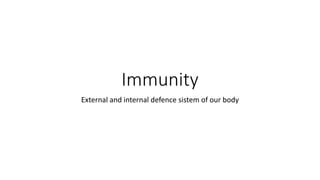
Immunity
- 1. Immunity External and internal defence sistem of our body
- 3. CELLS OF THE IMMUNE SYSTEM
- 5. PHAGOCYTOSIS Several types of cells in the immune system engulf microorganisms via phagocytosis. Eg: • Neutrophils. Neutrophils are abundant in the blood, quickly enter tissues, and phagocytize pathogens in acute inflammation. • Macrophages. • B Lymphocytes. A small amount of phagocytosis in these cells is often necessary in order for them to develop into cells that release antibodies.
- 6. SEQUENCE OF EVENTS • Phagocytosis begins with the neutrophil or macrophage flowing around the pathogen and engulfing it so that it winds up enclosed in a phagosome(phagocytic vesicle). • The next step is the fusion of lysosomes with the phagosome. The result is called a phagolysosome. Lysosome are derived from the Golgi apparatus, much like secretion vesicles, but their contents are focused on destroying microorganisms • The following are important factors that help destroy microorganisms within a phagolysosome. Eg: Oxygen Radicals, Nitric Oxide, Anti-Microbial Proteins. • In addition to destroying the microorganism, phagocytes also release molecules that diffuse to other cells and help coordinate the overall response to an infection.
- 9. B-Lymphocytes mechanisms • B-cells are activated when antigen binds to receptors on the B-cell surface, followed by a co-stimulatory signal. Co-stimulation is usually provided by an activated helper T-cell that secrets cytokines that specifically activate B-cells. • Antigens that require co-stimulation by a helper T-cell to activate a B-cell are T-dependent antigens and are usually proteins. • The activated B-cell clonally proliferates to produce a population of plasma cells and memory cells, which all recognize the same antigen. This process is called clonal selection. •Plasma cells produce antibodies, which are found in body fluids. •Memory cells recognize antigens from previous encounters and respond quickly to clonally proliferate. • Antigens that stimulate B-cells directly, without co-stimulation by helper T-cells, are T-independent antigens (usually polysaccharides or lipopolysaccharides ,like those found in bacterial capsules). • T-independent antigens don't generate as strong a response: no memory cells, IgM is the only antibody class produced, and the immunity doesn't last long.
- 14. ANTIBODIES Antibodies are proteins (immunoglobulins) produced by plasma cells in response to stimulation by a specific antigen, capable of binding to the antigen that stimulated their production. Antibodies have at least two identical antigen binding (valence) sites. Monomers consists of: • Two heavy chains • Two light chains Each chain has: • Variable portion - the antigen binding site • Constant portion - forms the base and Fc (the fragment that crystalizes in cold storage) region. • The variable portion will always be the same on antibodies produced by the same plasma cell, and will always recognize the antigen that originally stimulated its production
- 24. MONOCLONAL ANTIBODIES • Monoclonal antibodies (mAb or moAb) are antibodies that are made by identical immune cells that are all clones of a unique parent cell, in contrast to polyclonal antibodies, which are made from several different immune cells. • Applications 1. Once monoclonal antibodies for a given substance have been produced, they can be used to detect the presence of this substance. The Western blot test and immune dot blot tests detect the protein on a membrane. They are also very useful in immunohistochemistry, which detect antigen in fixed tissue sections and immunofluorescence test, which detect the substance in a frozen tissue section or in live cells. 2. Antibodies can also be used to purify their target compounds from mixtures, using the method of immunoprecipitation. 3. Therapeutic treatment. Therapeutic monoclonal antibodies act through multiple mechanisms, such as blocking of targeted molecule functions, inducing apoptosis in cells which express the target, or by modulating signalling pathways 4. Cancer treatment. One possible treatment for cancer involves monoclonal antibodies that bind only to cancer cell-specific antigens and induce an immune response against the target cancer cell.
- 26. SOME USEFUL LINKS • http://primaryimmune.org/about-primary- immunodeficiencies/relevant-info/the-immune-system/ • https://humanphysiology2011.wikispaces.com/08.+Immunology • http://classes.midlandstech.edu/carterp/Courses/bio225/chap17/Ad aptive_Immunity3.html